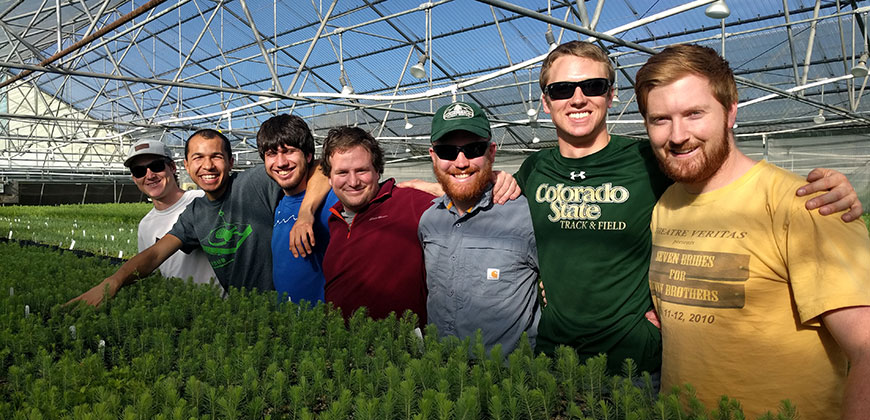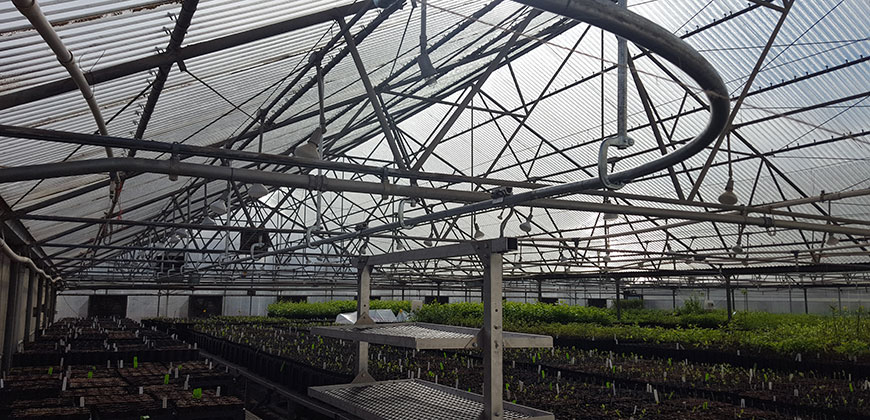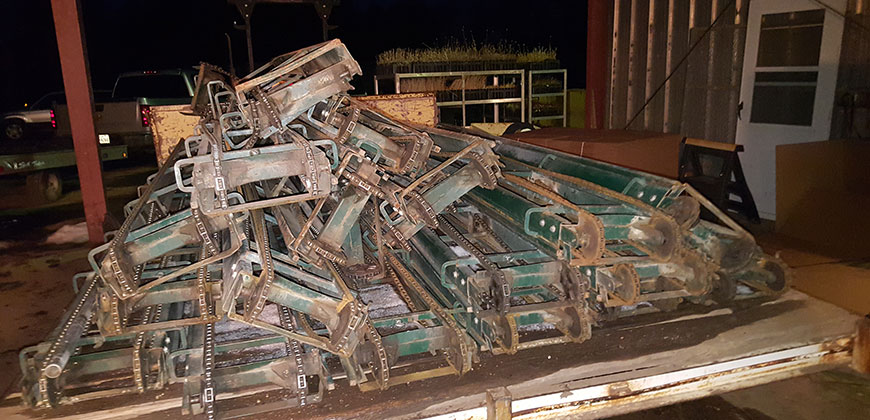
Mechanical engineering seniors Clay Hommel, Jofat “J.C.” Castillo, Tyler Beach, Evan Mackes, Hunter Novotny, Jace Horak and Robert Garren made a new seedling transport system for the Colorado State Forest Service Nursery.
It was the bane of their existence: a 50-year-old conveyor belt at the Colorado State Forest Service Nursery, used to transport hundreds of thousands of seedlings throughout 18,000 square feet of greenhouses. Crucial to the nursery’s day-to-day operations, the conveyor – like any mechanical equipment showing its age – kept breaking. And breaking.
They’ll never have to fix it again. CSU engineering students have spent the past seven months designing, building and installing a brand-new seedling transport system for the nursery. It’s allowed the nursery staff to increase their work productivity overnight, for a fraction of the cost to repair or replace the old system.
The new seedling conveyor was the seven-member mechanical engineering team’s senior design project, which they’ll present publicly during Engineering Days, April 14.
“It’s awesome to have a project we can call a success,” said student engineer Hunter Novotny – while quickly pointing out that they’re not quite done. “We hope it helps the nursery, and if we’re lucky, it’ll help the Colorado forests, too.”
The forest service’s nursery provides more than 50 native species of seedling trees, shrubs and perennials to landowners at low cost to assist with conservation efforts, including reforestation after fires, erosion control and enhancing wildlife habitats. The students’ project should be completed for the start of 2017 seedling deliveries.
The goal: better, cheaper
The students were initially tasked with improving the nursery’s old conveyor system. But after several rounds of discussion, they concluded they could make something better, for cheaper. According to nursery manager Joshua Stolz, the old system was a drain on resources, and more importantly, time.
“Anytime we were going to be seeding, we’d have to put that track all back together,” Stolz said. “Because of the age of the system, things didn’t fit well together anymore. Basically, on a good day, we might spend five hours assembling the track. On a bad day, it could be five days of things not lining up, or having to replace bushings.”
Stolz said replacing the old conveyor track would have cost the forest service a prohibitive $70,000. The students’ total project cost is slated to come in well under their initial estimate of $8,000. The forest service’s share was $3,500, which means Stolz just got a new, working seedling transport system at a very, very deep discount.
A monorail for seedlings
The students’ new system is 700 feet of overhead, hand-pushed monorail track that snakes the perimeter of adjoining greenhouses. The system also includes an upgraded gravel hopper where seedlings are initially loaded and transferred to carts. The carts, suspended from the monorail, can be pushed quickly to any corner of the vast greenhouses; the old system only provided access from one side of the greenhouses.

The students designed, built and installed a monorail system that allows for efficient transport of seedling trays.
On a tour of the new system, the students proudly zip through rows of a quarter-million seedling trees, pointing out this or that aspect of their design: bolts, C-brackets and reinforced purlins. Every belt, trolley head, cart frame and aluminum pipe is accounted for in detailed documentation the students will leave for the nursery, to guide future repairs or upgrades.
The project required the assistance of not only the nursery managers, but also CSU Facilities, which worked with the students to obtain permits for hanging structures from trusses and for welding on extra material. Though mechanical engineers by training, the students found themselves dabbling in structural engineering, as well as all the permitting, legal documentation, communication and bureaucracy that comes with installing new things in old buildings.
“All the agencies needed to be kept updated and in the loop,” said team member J.C. Castillo. “Therefore, there were quite a lot of fires that we had to put out.”
And the verdict? Stolz is beside himself with praise for the young engineers.
“I just can’t say enough about what they’ve done in terms of their diligence and their professionalism,” Stolz said. “They really embraced the idea of thinking outside the box, and in doing so they were able to deliver us something that is going to impact us from day one.”

The old conveyor belt system, off to surplus.